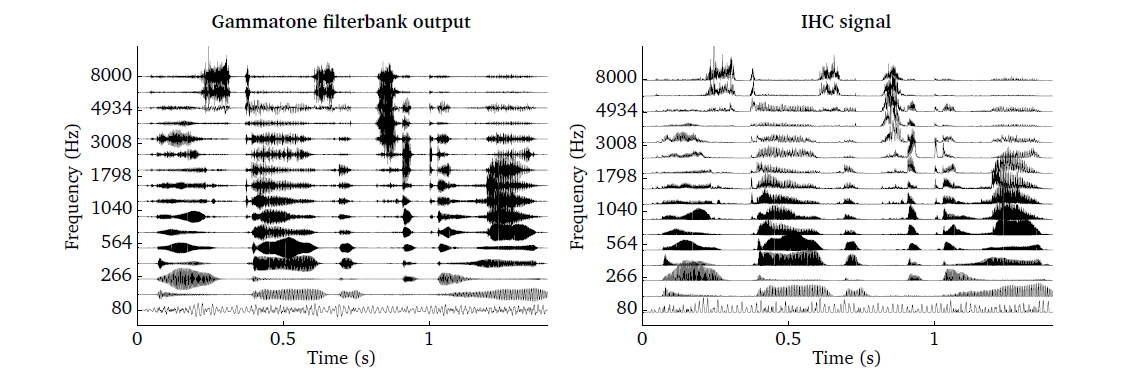Inner hair-cell (ihcProc.m)
The IHC functionality is simulated by extracting the envelope of the output of
individual gammatone filters. The corresponding IHC function is adopted from
the Auditory Modeling Toolbox [Soendergaard2013]. Typically, the envelope is extracted by
combining half-wave rectification and low-pass filtering. The low-pass filter is
motivated by the loss of phase-locking in the auditory nerve at higher
frequencies [Bernstein1996], [Bernstein1999]. Depending on the cut-off
frequency of the IHC models, it is possible to control the amount of
fine-structure information that is present in higher frequency channels. The
cut-off frequency and the order of the corresponding low-pass filter vary across
methods and a complete overview of supported IHC models is given in
Table 20. A particular model can be selected by using the
parameter ihc_method.
Table 20 List of supported IHC models
ihc_method |
Description |
|---|
'hilbert' |
Hilbert transform |
'halfwave' |
Half-wave rectification |
'fullwave' |
Full-wave rectification |
'square' |
Squared |
'dau' |
Half-wave rectification and low-pass filtering at 1000 Hz
[Dau1996] |
'joergensen' |
Hilbert transform and low-pass filtering at 150 Hz
[Joergensen2011] |
'breebart' |
Half-wave rectification and low-pass filtering at 770 Hz
[Breebart2001] |
'bernstein' |
Half-wave rectification, compression and low-pass filtering
at 425 Hz [Bernstein1999] |
The effect of the IHC processor is demonstrated in Fig. 24, where
the output of the gammatone filter bank is compared with the output of an IHC
model by running the script DEMO_IHC.m. Whereas individual peaks are
resolved in the lowest channel of the IHC output, only the envelope is
retained at higher frequencies.
| [Bernstein1996] | Bernstein, L. R. and Trahiotis, C. (1996), “The normalized correlation:
Accounting for binaural detection across center frequency,” Journal of the
Acoustical Society of America 100(6), pp. 3774–3784. |
| [Bernstein1999] | (1, 2) Bernstein, L. R., van de Par, S., and Trahiotis, C. (1999), “The normalized
interaural correlation: Accounting for NoS thresholds obtained with Gaussian
and “low-noise” masking noise,” Journal of the Acoustical Society of America
106(2), pp. 870–876. |
| [Breebart2001] | Breebaart, J., van de Par, S., and Kohlrausch, A. (2001), “Binaural
processing model based on contralateral inhibition. I. Model structure,”
Journal of the Acoustical Society of America 110(2), pp. 1074–1088. |
| [Dau1996] | Dau, T., Püschel, D., and Kohlrausch, A. (1996), “A quantitative model of
the “effective” signal processing in the auditory system. I. Model
structure,” Journal of the Acoustical Society of America 99(6), pp.
3615–3622. |
| [Joergensen2011] | Jørgensen, S. and Dau, T. (2011), “Predicting speech intelligibility based
on the signal-to-noise envelope power ratio after modulation-frequency
selective processing,” Journal of the Acoustical Society of America 130(3),
pp. 1475–1487. |
